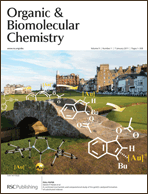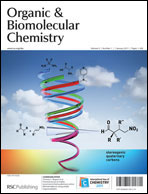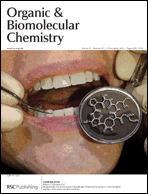The first issue of Organic & Biomolecular Chemistry 2011 (coming soon) is another very impressive and high quality issue that contains top articles by very well respected scientists in the field of organic chemistry.
Here you have an advance: A list of the articles in the issue that deal with natural products.
Take a look at them and keep an eye on this successful first issue coming later this week.
Total syntheses of subereamollines A and B
James W. Shearman, Rebecca M. Myers, James D. Brenton and Steven V. Ley
Org. Biomol. Chem., 2011, Advance Article
DOI: 10.1039/C0OB00636J, Communication
First total synthesis of antrocamphin A and its analogs as anti-inflammatory and anti-platelet aggregation agents
Chia-Lin Lee, Chi-Huan Huang, Hui-Chun Wang, Da-Wei Chuang, Ming-Jung Wu, Sheng-Yang Wang, Tsong-Long Hwang, Chin-Chung Wu, Yeh-Long Chen, Fang-Rong Chang and Yang-Chang Wu
Org. Biomol. Chem., 2011, Advance Article
DOI: 10.1039/C0OB00616E, Communication
First total synthesis of (−)- and (+)-6-O-desmethylantofine
Meng Wu, Ling Li, Bo Su, Zhihui Liu and Qingmin Wang
Org. Biomol. Chem., 2011, Advance Article
DOI: 10.1039/C0OB00287A, Paper
Computational and experimental investigations of mono-septanoside binding by Concanavalin A: correlation of ligand stereochemistry to enthalpies of binding
Michael R. Duff Jr., W. Sean Fyvie, Shankar D. Markad, Alexandra E. Frankel, Challa V. Kumar, José A. Gascón and Mark W. Peczuh
Org. Biomol. Chem., 2011, Advance Article
DOI: 10.1039/C0OB00425A, Paper
Synthesis and NMR spectroscopic analysis of acylated pentasaccharide fragments of mycobacterial arabinogalactan
Chunjuan Liu, Michele R. Richards and Todd L. Lowary
Org. Biomol. Chem., 2011, Advance Article
DOI: 10.1039/C0OB00423E, Paper
Synthesis and assignment of stereochemistry of the antibacterial cyclic peptide xenematide
Kuo-yuan Hung, Paul W. R. Harris, Amanda M. Heapy and Margaret A. Brimble
Org. Biomol. Chem., 2011, Advance Article
DOI: 10.1039/C0OB00315H, Paper
Total synthesis of (−)-20-epiuleine via stereocontrolled one-pot asymmetric azaelectrocyclization followed by novel 1,4-addition reaction
Taku Sakaguchi, Shohei Kobayashi and Shigeo Katsumura
Org. Biomol. Chem., 2011, Advance Article
DOI: 10.1039/C0OB00627K, Paper
Synthesis of dysideaproline E using organocatalysis
Ernest Owusu-Ansah, Amanda C. Durow, John R. Harding, Angela C. Jordan, Susan J. O’Connell and Christine L. Willis
Org. Biomol. Chem., 2011, Advance Article
DOI: 10.1039/C0OB00617C, Paper












 Thomas Nugent and colleagues at Jacobs University describe the use of a three component catalyst, an amino acid, a base and a hydrogen bond donor, to form quaternary C-C bonds in this paper that is the front cover of
Thomas Nugent and colleagues at Jacobs University describe the use of a three component catalyst, an amino acid, a base and a hydrogen bond donor, to form quaternary C-C bonds in this paper that is the front cover of  Oxford
Oxford The very successful OBC Communication by Robert H. Cichewicz and coworkers, at the University of Oklahoma, on mutanobactin A and its influence on the yeast-mycelium transition of Candida albicans is now the inside cover of Issue 24.
The very successful OBC Communication by Robert H. Cichewicz and coworkers, at the University of Oklahoma, on mutanobactin A and its influence on the yeast-mycelium transition of Candida albicans is now the inside cover of Issue 24. Rajeev Menon and Martin Banwell at the Australian National University in Camberra have identified a novel and highly efficient Au (I) catalysed intramolecular Michael addition reaction that is a key step towards the first total synthesis of crassifolone and dihydrocrassifolone.
Rajeev Menon and Martin Banwell at the Australian National University in Camberra have identified a novel and highly efficient Au (I) catalysed intramolecular Michael addition reaction that is a key step towards the first total synthesis of crassifolone and dihydrocrassifolone.